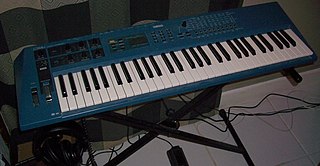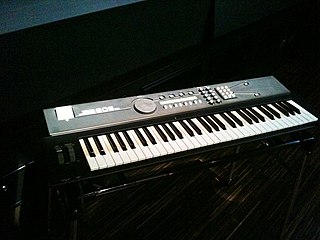General MIDI is a standardized specification for electronic musical instruments that respond to MIDI messages. GM was developed by the American MIDI Manufacturers Association (MMA) and the Japan MIDI Standards Committee (JMSC) and first published in 1991. The official specification is available in English from the MMA, bound together with the MIDI 1.0 specification, and in Japanese from the Association of Musical Electronic Industry (AMEI).

The Roland MC-303 is the first of a series of musical instruments known as a groovebox. It combines a simple sound module with a sequencer to record and store notation, along with controls aimed at encouraging the musician to improvise the music while it is playing. Despite the number in its name and the attention it received at its launch, the MC-303 has more in common with other MC prefixed synthesizers, which contain built-in sequencers, than it does with the famous Roland TB-303. As the first Groovebox, the MC-303 was the first in a line of inexpensive products specifically targeted towards house DJs and amateur home musicians rather than professional producers. It was superseded by the Roland MC-505. It is the predecessor to the Roland JX-305, Roland D2, Roland MC-307, Roland EG-101, Roland MC-09, Roland MC-909, Roland MC-808, and most recently the Roland MC-707 in 2019, along with its more portable sibling, the Roland MC-101.

Yamaha XG is an extension to the General MIDI standard, created by Yamaha. It is similar in purpose to the Roland GS standard.
The Yamaha AN1x is a DSP-based analog modeling synthesizer, produced by Yamaha Corporation from 1997 to 1998, and was marketed as an "analog physical modelling control synthesizer".

A sound module is an electronic musical instrument without a human-playable interface such as a piano-style musical keyboard. Sound modules have to be operated using an externally connected device, which is often a MIDI controller, of which the most common type is the musical keyboard. Another common way of controlling a sound module is through a sequencer, which is computer hardware or software designed to record and playback control information for sound-generating hardware. Connections between sound modules, controllers, and sequencers are generally made with MIDI, which is a standardized interface designed for this purpose.

The Yamaha RM1x is a groovebox manufactured by Yamaha from 1999 to 2002. It integrates several, commonly separate, pieces of music composition and performance hardware into a single unit: a step-programmable drum machine, a synthesizer, a music sequencer, and a control surface.

The Yamaha Motif is a series of music workstation synthesizers, first released by Yamaha Corporation in August 2001. The Motif replaced the EX series in Yamaha's line-up and was also based on the early Yamaha S series. Other workstations in the same class are the Korg Kronos and the Roland Fantom G. The series' successor is Yamaha Montage, released in 2016, followed up by the Yamaha Montage M in 2023.
Roland GS, or just GS, sometimes expanded as General Standard or General Sound, is a MIDI specification. It requires that all GS-compatible equipment must meet a certain set of features and it documents interpretations of some MIDI commands and bytes sequences, thus defining instrument tones, controllers for sound effects, etc.

The Korg Wavestation is a vector synthesis synthesizer first produced in the early 1990s and later re-released as a software synthesizer in 2004. Its primary innovation was Wave Sequencing, a method of multi-timbral sound generation in which different PCM waveform data are played successively, resulting in continuously evolving sounds. The Wavestation's "Advanced Vector Synthesis" sound architecture resembled early vector synths such as the Sequential Circuits Prophet VS.

The Roland JD-800 is a digital synthesizer that was manufactured between 1991 and 1996. It features many knobs and sliders for patch editing and performance control — features that some manufacturers, including Roland, had been omitting in the name of streamlining since the inception of the Yamaha DX7. The JD-800 thus became very popular with musicians who wished to take a hands-on approach to patch programming. The introduction in the manual states that Roland's intention with the JD-800 was to "return to the roots of synthesis".
The Yamaha SY85 is a digital music workstation introduced in 1992. Unlike other Yamaha synthesizers of the time the SY85 does not use FM synthesis. Instead, its sounds are based on samples, which can be layered and modified to create new sounds.

A guitar synthesizer is any one of a number of musical instrument systems that allow a guitarist to access synthesizer capabilities.

The Yamaha CS1x is a sample-based synthesizer released by the Yamaha Corporation in 1996. Aimed primarily at dance musicians, the CS1x features analogue synthesizer-style rotary controllers and monotimbral synth voices.
The CS1x was succeeded in 1999 by the CS2x synthesizer.
The Yamaha V50 is a hybrid music workstation introduced in 1989. It combines a sequencer, rhythm machine, an FM synthesis-based sound module and a MIDI keyboard.

The Sirius is a keyboard "groove-synth," featuring a subtractive hybrid-tone-generation synthesizer referred to as DTE synthesis introduced in 1997 by Quasimidi. The unit featured both real-time and step sequencers with pattern- and song-modes, capable of acting basic drum machine, groove-box, or sound-module.

The Split-8 is a polyphonic analogue keyboard synthesizer manufactured by Sequential Circuits. Built in Japan and going by the alternative name Pro-8 in some markets, this was one of the last synthesizers produced by the company and was assigned model number 608. It was released in 1985 at a list price of $1,199. This and some other Sequential Circuits synthesizers were built around the Curtis Electronics CEM 3394 "synth-on-a-chip" integrated circuit, and used a Z80 as their central microprocessor.

The Yamaha YS200 is an FM synthesiser and workstation produced by Yamaha, introduced in 1988. It combines a sequencer, rhythm machine, an FM synthesis soundchip and a MIDI keyboard. It was called the EOS YS200 in Japan and was also released as a more home-oriented keyboard in the form of the Yamaha EOS B200, which also featured built-in stereo speakers. The YS200 is the keyboard equivalent of the Yamaha TQ5 module. The forerunner of the YS200 was the almost-identical Yamaha YS100.

The Yamaha DX21 is a digital controlled bi-timbral programmable digital FM synthesizer with a four operator synth voice generator which was released in 1985. It uses sine wave-based frequency modulation (FM) synthesis. It has two FM tone generators and a 32-voice random-access memory (RAM), 32 user voices and 128 read-only memory (ROM) factory preset sounds. As a programmable synth, it enables users to create their own unique synthesized tones and sound effects by using the algorithms and oscillators. The instrument weighs 8 kg (17.6 lbs). On its release, it sold for $795.
The Korg DRM-1 Digital Rhythm module built by Korg, in late 1987. It was introduced during 1987 Summer NAMM industry trade show in Chicago.














